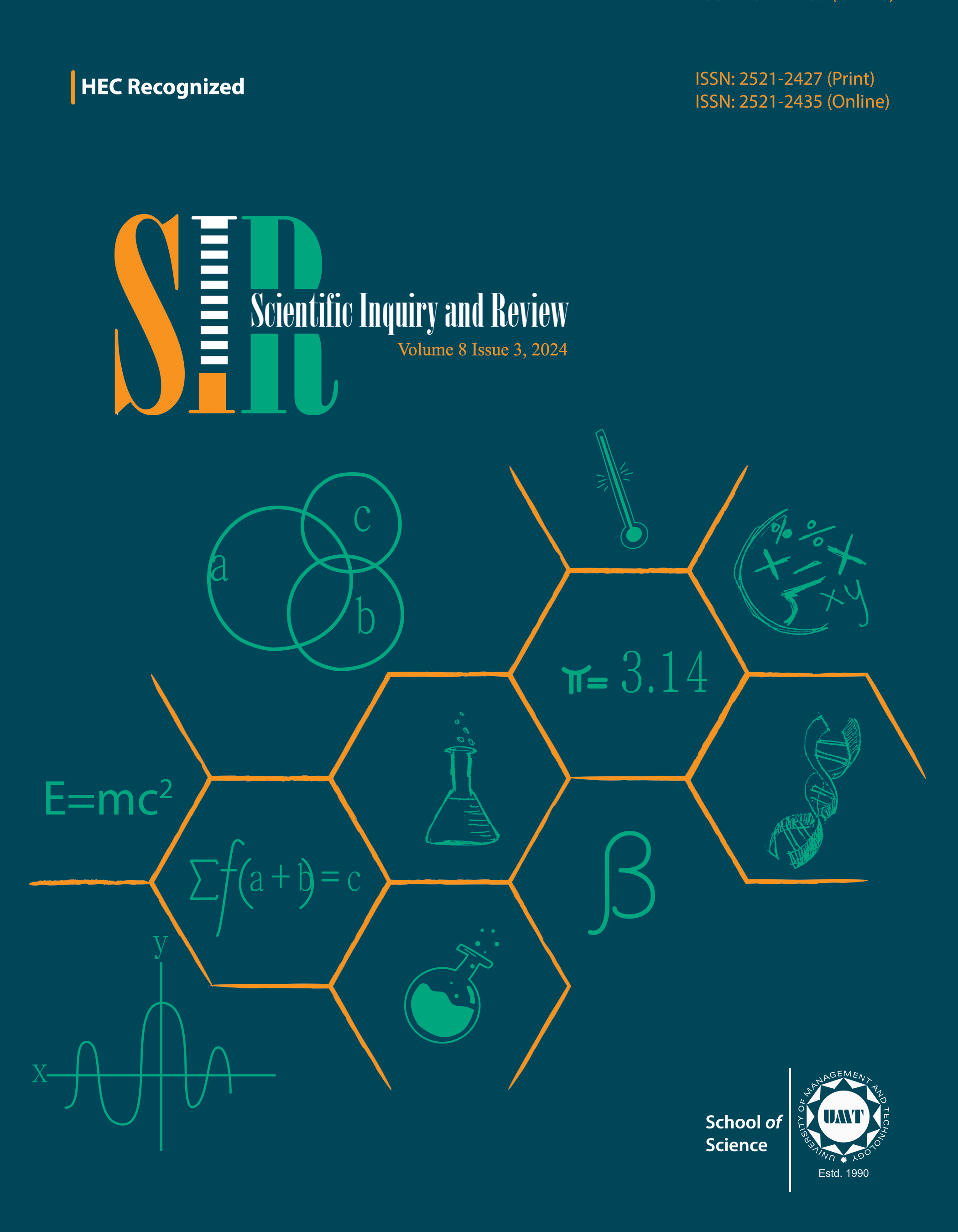Comparison of Adams-Bashforth-Moulton and Dormand-Prince Methods in Lengyel-Epstein Reaction Model Forming Zinc Oxide Nanostructures
Abstract
 Abstract Views: 0
Abstract Views: 0
This study adopts a numerical approach in the Lengyel-Epstein reaction model for forming zinc oxide (ZnO) nanostructures. It aims to determine the optimal approximation technique to analyze the growth of ion concentrations in ZnO nanostructures. For this purpose, ordinary differential equations are developed using the Dormand-Prince method in the Lengyel-Epstein reaction model. The results obtained from this technique are compared with the results obtained from the Adams-Bashforth-Moulton (ABM) method. After a comparative analysis of both methods, the results showed that the ABM method performs better than the Dormand-Prince method. The accuracy and stability of the ABM method are higher than those of the Dormand-Prince method. Furthermore, error analysis for both methods confirms that the results obtained from the former are more optimized. Moreover, this method also validates the results obtained from the experimental procedure by using the aqueous chemical growth (ACG) method to form the nanostructures of ZnO.
Downloads
References
. Siddiqi KS, Rahman A, Tajuddin, Husen A. Properties of zinc oxide nanoparticles and their activity against microbes. Nanoscale Res Lett. 2018;13:e141. https://doi.org/10.1186/s11671-018-2532-3
Ali B, Khan AA. Real-time distribution system analysis and load management algorithm for minimizing harmonics. Roman J Tech Sci. 2021;66(4):237–242.
Ali B, Khan AA, Ali A, Maqsood M, Nisha R. Power loss reduction of distribution network in densely industrialized coastal belt by development of hydrophobic coating applying accelerated aging for ceramic insulator. ASEAN Eng J. 2022;12(1):111–117. https://doi.org/10.11113/aej.v12.17209
Fatima K, Khan A, Hussain M. Mathematical modelling of reaction kinematics of one dimensional Zinc oxide nanostructures. NED Univ J Res. 2018;15(4):117–122.
Holmes AM, Song Z, Moghimi HR, Roberts MS. Relative penetration of zinc oxide and zinc ions into human skin after application of different zinc oxide formulations. ACS Nano. 2016;10(2):1810–1819. https://doi.org/10.1021/acsnano.5b04148
Mishra PK, Mishra H, Ekielski A, Talegaonkar S, Vaidya B. Zinc oxide nanoparticles: a promising nanomaterial for biomedical applications. Drug Discov Today. 2017;22(12):1825–1834. https://doi.org/10.1016/j.drudis.2017.08.006
Sabir S, Arshad M, Chaudhari SK. Zinc oxide nanoparticles for revolutionizing agriculture: synthesis and applications. Sci World J. 2014;2014(1):e925494. https://doi.org/10.1155/2014/925494
Jiang J, Pi J, Cai J. The advancing of zinc oxide nanoparticles for biomedical applications. Bioinorg Chem Appl. 2018;2018(1):e1062562. https://doi.org/10.1155/2018/1062562
Tang E, Cheng G, Ma X, Pang X, Zhao Q. Surface modification of zinc oxide nanoparticle by PMAA and its dispersion in aqueous system. Appl Surf Sci. 2006;252(14):5227–5232. https://doi.org/10.1016/j.apsusc.2005.08.004
Kulkarni SS, Shirsat MD. Optical and structural properties of zinc oxide nanoparticles. Int J Adv Res Phys Sci. 2015;2(1):14–18.
Gaspar D, Pereira L, Gehrke K, Galler B, Fortunato E, Martins R. High mobility hydrogenated zinc oxide thin films. Sol Energy Mater Sol Cells. 2017;163:255–262. https://doi.org/10.1016/j.solmat.2017.01.030
Ding M, Guo Z, Zhou L, et al. One-dimensional zinc oxide nanomaterials for application in high-performance advanced optoelectronic devices. Crystals. 2018;8(5):e223. https://doi.org/10.3390/cryst8050223
Rahman F. Zinc oxide light-emitting diodes: a review. Opt Eng. 2019;58(1):010901–010901. https://doi.org/10.1117/1.OE.58.1.010901
Jitianu M, Goia DV. Zinc oxide colloids with controlled size, shape, and structure. J Colloid Interface Sci. 2007;309(1):78–85. https://doi.org/10.1016/j.jcis.2006.12.020
Li D, Haneda H. Morphologies of zinc oxide particles and their effects on photocatalysis. Chemosphere. 2003;51(2):129–137. https://doi.org/10.1016/s0045-6535(02)00787-7
Moezzi A, McDonagh AM, Cortie MB. Zinc oxide particles: Synthesis, properties and applications. Chem Eng J. 2012;185:1–22. https://doi.org/10.1016/j.cej.2012.01.076
Begum PS, Joseph R, Yusuff KM. Preparation of nano zinc oxide, its characterization and use in natural rubber. Prog Rubber Plast Recycl Technol. 2008;24(2):141–152. https://doi.org/10.1177/147776060802400204
Osman DAM, Mustafa MA. Synthesis and characterization of zinc oxide nanoparticles using zinc acetate dihydrate and sodium hydroxide. J Nanosci Nanoeng. 2015;1(4):248–251.
Fatima K, Ali B, Mahnoor. Implementation of lengyel-epstein reaction model for zinc Oxide (ZnO) nanostructures by comparing euler and fourth-order Runge–Kutta (RK) methods. Sci Inq Rev. 2022;6(1):23–33. https://doi.org/10.32350/sir.61.02
Mammah SL, Opara FE, Sigalo FB, Ezugwu SC, Ezema FI. Effect of concentration on the optical and solid state properties of ZnO thin films deposited by aqueous chemical growth (ACG) method. J Mod Phys. 2012;3(10):1516–1522.
Dormand JR, Prince PJ. A family of embedded Runge-Kutta formulae. J Comput Appl Math. 1980;6(1):19–26. https://doi.org/10.1016/0771-050X(80)90013-3
Ang TK, Hamzah A, Shamsidah N. Solving Ordinary Differential Equations by the Dormand Prince Method. Penerbit UTHM; 2018.
Shaikh WA, Keerio MU, Shaikh AG, Naz L, Sheikh AH. Higher order runge-kutta method for solving system of ordinary differential equations using MS excel. Quaid-E-Awam Univ Res J Eng Sci Technol Nawabshah. 2021;19:36–41. https://doi.org/10.52584/qrj.1902.06
Lee CY, Wang J, Chou Y, et al. White-light electroluminescence from ZnO nanorods/polyfluorene by solution-based growth. Nanotechnology. 2009;20(42):e425202. https://doi.org/10.1088/0957-4484/20/42/425202
Chicone C. Mathematical modeling and chemical kinetics. University of Missouri; 2010. https://www.simiode.org/resources/7215/download/2010-Chicone-MathModelingANDChemicalKinetics.pdf
Mishra YK, Modi G, Cretu V, et al. Direct growth of freestanding ZnO tetrapod networks for multifunctional applications in photocatalysis, UV photodetection, and gas sensing. ACS Appl Mater Interfaces. 2015;7(26):14303–14316. https://doi.org/10.1021/acsami.5b02816
Caetano BL, Santilli CV, Meneau F, Briois V, Pulcinelli SH. In situ and simultaneous UV- vis/SAXS and UV- vis/XAFS time-resolved monitoring of ZnO quantum dots formation and growth. J Phys Chem C. 2011;115(11):4404–4412. https://doi.org/10.1021/jp109585t
Copyright (c) 2024 basit ali, KANIZ FATIMA

This work is licensed under a Creative Commons Attribution 4.0 International License.






